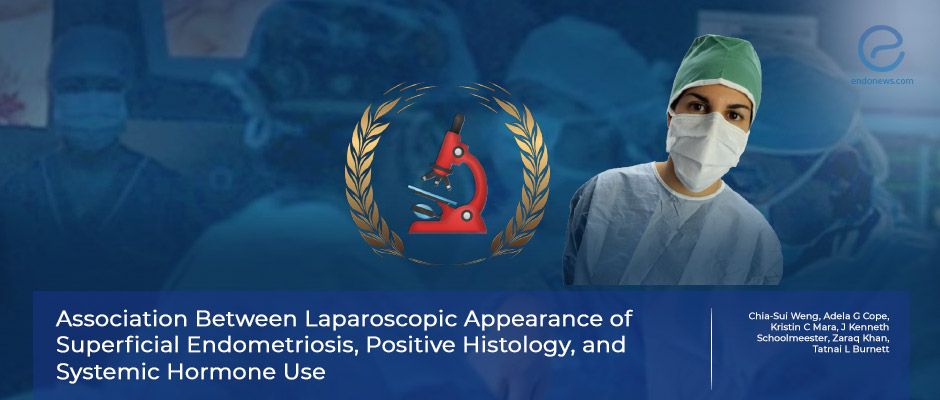Understanding what we see: endometriosis laparoscopic appearance and microscopic verification
Nov 4, 2022
A panoramic evaluation of the diagnostic gold standard in endometriosis
Key Points
Highlights:
- The precise diagnosis of endometriosis still depends on the surgical biopsy's histopathologic (i.e. microscopic) assessment.
- However, this is not an easy task and may have difficulties due to various factors that depend on the patient and surgical pathologists in particular.
Importance:
- As a gold standard, laparoscopic biopsies yield opportunities to confirm endometriosis via a pathologist’s microscope -there is a need for synchronization of phenotypic surgical and clinical data.
- The "World Endometriosis Research Foundation Endometriosis Phenome and Biobanking Harmonisation Project" has reported a consensus for standard recommended surgical data collection.
What's done here:
- The aim was to assess the association between the laparoscopic appearance of superficial endometriosis lesions, histopathology, and systemic hormone use.
- A retrospective study from a tertiary care academic medical center was performed.
- a total of 266 women who underwent laparoscopic surgery containing lesions consistent with possible superficial endometriosis were evaluated.
- The World Endometriosis Research Foundation guidelines were used for the gross appearance of endometriosis from 194 patients who had video documentation available for review.
- The correlation between systemic hormone therapy and the appearance of endometriotic lesions was also compared.
Key Results:
- A total of 841 biopsy assessments were reevaluated: 251 samples were negative and 590 were positive for "endometriosis" on pathology assessment.
- When the histology and lesion color were compared, the likelihood of endometriosis in histology was as follows: red (OR 1.70, 95%CI 1.17-2.48), white (OR 1.99, 95%CI 1.47-2.70), blue/black (OR 2.98, 95%CI 2.00-4.44), or puckering (OR 9.78, 95%CI 2.46-38.91).
- The combined characteristics for a higher probability of positive histology are white and blue (OR 5.98, 95%CI 2.97-12.02), red and white (OR 2.22, 95%CI 1.38-3.56), red and blue (OR 4.11, 95%CI 1.83-9.24), and clear and white (OR 8.77, 95%CI 1.17-66.02).
- Among positive biopsies, the samples from the patients with hormone exposure were more likely to have clear lesions than those without hormone use (OR 3.36, 95% CI 1.54-7.34), and were 2.89 times more likely to have clear and white lesions (95% CI 1.07-7.85).
- Briefly, the gross appearances suspicious for endometriosis may have differing rates of positive histopathology positivity verification. Hormonal therapies may influence lesion appearance at the time of surgery, resulting in a higher prevalence of clear lesions.
Lay Summary
Chia-Sui Weng and colleagues from the Mayo Clinic, USA have published their results on laparoscopic appearances and microscopy of endometriotic lesions in “The Journal of Minimally Invasive Gynecology”.
Even though the diagnosis of endometriosis has evolved greatly with advanced imaging techniques surgery with histopathologic evaluation is still the diagnostic gold standard. Nevertheless, this diagnostic pathway may have difficulties due to various factors depending on the patient and surgical pathologist.
Laparoscopic biopsies yield opportunities in confirming endometriosis via the pathologist’s microscope but there is a need for synchronization of all data. This retrospective research has taken into consideration the World Endometriosis Research Foundation Endometriosis Phenome and Biobanking Harmonisation Project’s consensus for standard recommended surgical data. Laparoscopic appearances of endometriosis in 194 patients who had video documentation available for review from their laparoscopies and a total of 841 biopsy assessments were reevaluated. Additionally, the correlation between systemic hormone therapy and the appearance of endometriotic lesions were also correlated.
Lesions had a significantly higher probability of histopathological positivity for endometriosis when they were red (OR 1.70, 95%CI 1.17-2.48, PPV 78%, NPV 32%), white (OR 1.99, 95%CI 1.47-2.70, PPV 77%, NPV 37%), blue/black (OR 2.98, 95%CI 2.00-4.44, PPV 85%, NPV 35%), or puckering (OR 9.78, 95%CI 2.46-38.91, PPV 96%, NPV 31%) in appearance.
As a major conclusion of this research, intraoperative lesions suspicious for endometriosis had differing rates of positive histopathology based on appearance, no characteristic finding was able to exclude the possibility of endometriosis. Besides, hormonal therapies may influence lesion appearance at the time of surgery, with clear lesions being more prevalent.
Authors conclude that new research projects are needed to determine whether endometriotic lesions could be clarified via gross appearances. Prediction of clinical outcomes after precise and definitive surgical treatment for endometrial implants needs to be explored.
Research Source: https://pubmed.ncbi.nlm.nih.gov/36154901/
endometriosis hormones laparoscopy histopathology biopsy

